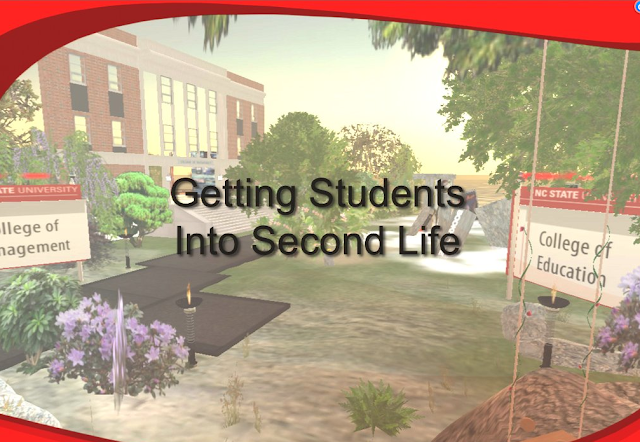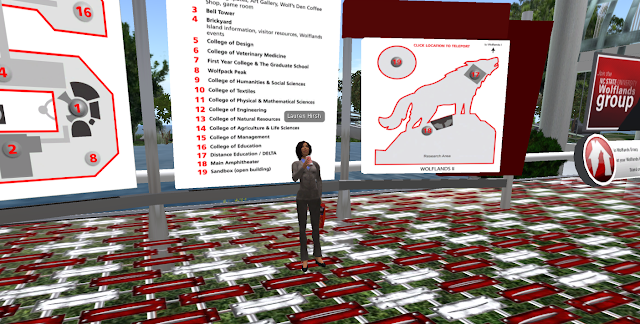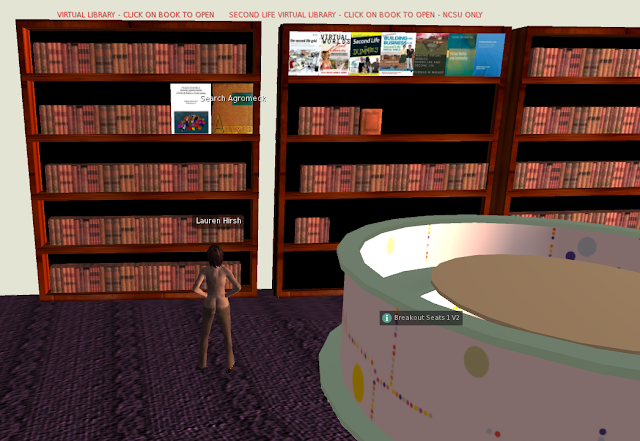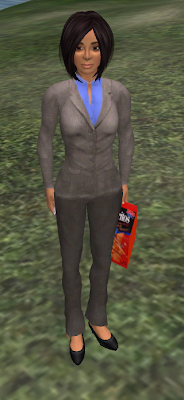As part of our unit on 'Community in the online environment', I have been exploring the potential affordances and barriers to using Second Life in distance education courses. After reading several research studies published between 2009 and 2013 in
Computers & Educationand the British Journal of Educational Technology (two of the top journals in the field of instructional technology), as well as watching the December, 2010 recording of a DELTA workshop, Creating Community with Second Life (see 'Archived Seminars'; must use Unity ID and password to view) and even 'traveling' to NC State's Wolflands islands to try Second Life out for myself, I am intrigued by the opportunities offered by Second Life but skeptical about its acceptance and use among faculty and students.
According to Steven Warburton (2009), virtual environments have three critical components: (a) technical, (b) immersive, and (c) social. While I admittedly have had little exposure to multi-user virtual environments (MUVEs) and massively multiplayer online games (MMOs), I found Second Life to offer a truly immersive experience. And Second Life is certainly capable of providing rich social interaction relative to simple online chat services, social media outlets, and discussion forums.
When considering interaction in a 3D Virtual World such as Second Life, one finds there are a number of benefits and drawbacks to using it in online education, discussed at length by Warburton (2009) and Petrakou (2010). The added spatial dimension and "augmented sense of presence" (Warburton, p 421) allows for enhanced interactivity and leads to more "informal, non-task specific interaction between students," which in turn contributes to socialization. (Petrakou, 2010, p. 1026). Petrakaou (2010) cites the synchronous interaction features of Second Life (including both public and private chat functions and voice-enabled communication) as a major benefit, given previous research findings that synchronous communication is important for building ties between students as well as improving teacher-student feedback. Wonderful in theory, but in a description of the findings from her ethnographic case study of the use of Second Life in an 'Oral Production' course, she reports that spoken communication was actually quite problematic for the teacher and the 14 students present in the environment. Between the trouble students without experience navigating worlds had in maneuvering their avatars, the number of students trying to communicate (without a clear, previously established voice protocol), and the challenging voice and/or headset configurations, the result was disruptive: "It was difficult to distinguish who was speaking and it was also difficult to find a reasonably quiet place for discussions" (p. 1026). (In Second Life, voices carry differently than in the real world. Even avatars who are at a considerable distance might sound as though they are very close by.) She also mentions that "if technical problems occur, it is not immediately obvious to the teacher and other students due to delay in the Second Life application" (p. 1023).
What is apparent to me from the research literature is that the Second Life has a lot to offer in regards to both the immersive and the social aspects. When it comes to the technical, however, there are many challenges, and while I did not utilize the voice functionality, my trip to the NC State Wolflands in Second Life was further confirmation of this. While these technical difficulties, whether attributable to the technology or lack of technical skills in operating the application, are not insurmountable, they are likely to deter many faculty from using this otherwise great tool.
My Trip to Second Life
After watching the DELTA seminar recording mentioned above, I decided to spend some time playing with Second Life in the world created by NC State staff for use by University instructors and students. The following is a summary of my experience and its impact on my impressions on the viability of using Second Life in online courses.
 |
| (image from DELTA workshop slides) |
I was both frustrated and fascinated by what I could do and see in Second Life. On the one hand, the interface and controls (particularly the controls for movement) are very clunky and hardly user friendly. It took what felt like forever to get the hang of it...even just a little. I could never seem to get the camera to point the right way or move to where I wanted to go. The directory of landmarks is right behind me but I had a heck of a time making my way over to it!
 |
| At the Brickyard (I think!) |
At the same time, I was utterly amazed by the resources one could find by exploring. For instance, in the Library Learning Commons, there are shelves of books that actually link to ebooks through the NCSU library! Beside them are several tables for breakout group conversations.
 |
| Browsing the Virtual Library bookshelves (Oy, I don't like the way those pants and jacket look from behind!) |
There are some vending machines on the islands (as well as a nice-looking cafe and a game room/lounge), so I got myself a Diet Coke and Doritos on my way to check out a great art show and a student exhibition. (I'm not sure why I bothered to get the diet soda though, since my avatar doesn't exactly need to worry about her sugar consumption. I guess it's a simple example of how some of our real-world behaviors and habits carry over to the virtual environment!)
 |
| Lovely room Associate Professor Patrick Fitzgerald's art work |
 |
| At the Digital Imaging (ADN 219) Student Exhibition |
I also went to an area where DELTA gives presentations and found resources on fostering student engagement in a synchronous web conferencing environment. Very cool!
 |
| Checking out 'teaching and learning with technology' resources from DELTA |
Best of all, I went to the 'Sandbox' (it is literally a big mound of graphic sand on Wolflands2) where I figured out how to build objects in Second Life and set about constructing a set of tables and lamps, bean bag chairs. I set out a plate of fruit, then sat down to watch the sunset. (I'm rather proud of my lamps, which illuminate the areas right around them when night falls on the island.)
 |
| Sitting by my lonesome, watching the sun set over NC State Wolflands (Check out this seating area I made!) |
All in all, the exploring was fun but very lonely. It would be more fun running around with a pack. I saw absolutely no one except for Melissa near the School of Management, whose avatar looked awesome in her steampunk outfit. We chatted for a few minutes, which was really nice. :)
In conclusion, Second Life has the potential to be an enjoyable, engaging, and community building experience....
if sufficient time in a course can be dedicated to letting students learn to use the application and their avatars, work through technical requirements and issues, establish communication ground rules and expected social norms. Who knows, maybe educators will give Second Life a second chance. I think it deserves it, and I intend to explore Wolflands more in the future. Hopefully, I can do it with a pack of colleagues and classmates!
References
Petrakou, A. (2010). Interacting through avatars: Virtual worlds as a context for online education. Computers & Education, 54(4), 1020-1027.
Warburton, S. (2009). Second Life in higher education: Assessing the potential for and the barriers to deploying virtual worlds in learning and teaching. British Journal of Educational Technology, 40(3), 414-426.









Hi Lauren,
ReplyDeleteGreat post -You found so many more cool areas on the island! And you found snacks! I'm glad we were able to chat in SL for a bit, that was fun :) Your screenshots are awesome, I am going to have to go back and explore more of the island. Also the comment about the diet coke is hilarious! It is amazing to me how we want to make sure our Avatars are happy in their virtual world - maybe that is why The Sims did so well....
-Melissa